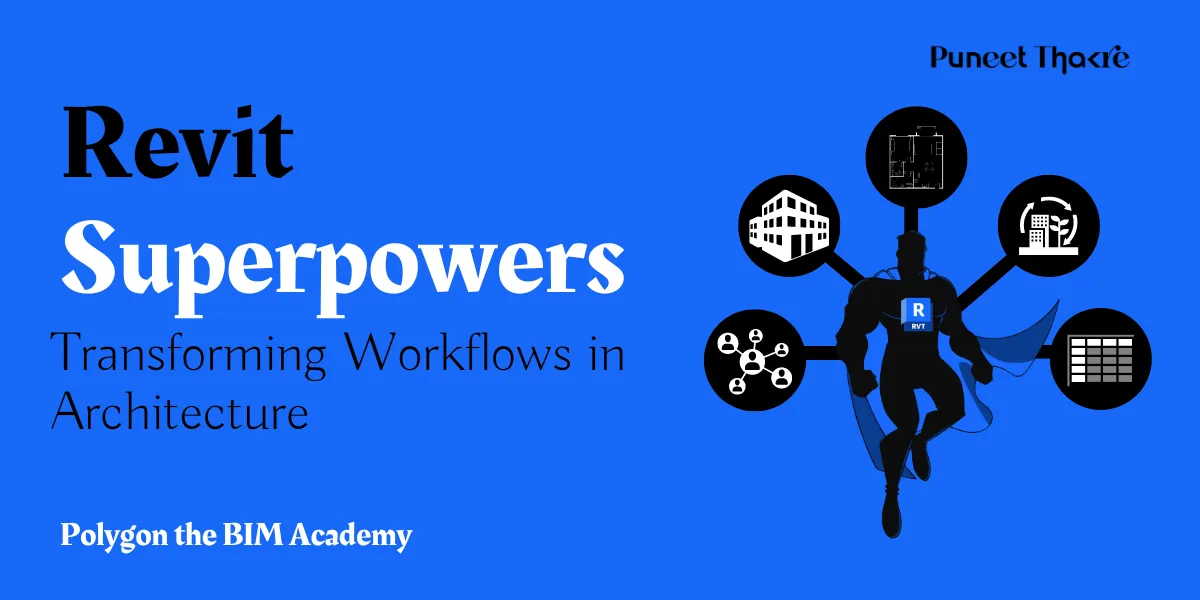#Revit Superpowers
Hello Architects & AEC Enthusiasts!
Ever wondered how modern architecture keeps pushing the boundaries of creativity and efficiency? Behind the breathtaking skylines and innovative designs lies a superpower known to the industry insiders as Revit. A powerhouse in building information modeling (BIM) software, Revit is not just a tool; it's a game-changer for architects, engineers, and designers alike. This article will explore the magic behind Revit and how it's making workflows smarter, quicker, and more efficient than ever before. So, buckle up as we embark on this exciting journey to uncover the superpowers of Revit!
Revit Superpowers: Transforming Workflows in Architecture
In the bustling world of architectural design, there's a silent hero that's been revolutionizing the way we create, collaborate, and bring our grand visions to life. It's called Revit, and trust me, it's more than just software—it's the superpower every architect dreams of having in their toolkit. Today, I'm thrilled to take you on a journey through the incredible capabilities of Revit and how it's making our architectural workflows smarter, quicker, and more efficient.
What's the Big Deal About Revit?
Imagine having a magic wand that not only helps you draw up those intricate designs but also ensures that every beam, window, and door aligns perfectly with your vision. That's Revit for you—a powerhouse in the realm of Building Information Modeling (BIM) software that's changing the game for architects and designers.
The Genesis of Revit: A Quick Look Back
Revit didn't just appear out of thin air. It was born out of necessity, a solution to the growing complexity in architectural projects. Its evolution over the years has been nothing short of a revolution, providing a comprehensive toolset that handles everything from initial conceptualization to the final construction details.
Revit stands for "Revise it"
Revit, short for "revise it," was conceptualized as a software that lived up to its name, allowing architects and designers to easily modify their designs at any stage of the project, with all elements of the model automatically updating to reflect changes. This was revolutionary. For the first time, architects could work in a true 3D environment that dynamically updated blueprints, elevations, and sections, streamlining their workflow and reducing the margin for error.
Embracing the BIM Revolution
The real turning point for Revit and the industry came with the widespread adoption of Building Information Modeling (BIM). Revit was at the forefront of this shift, embodying the principles of BIM by integrating physical and functional characteristics into a digital representation of the project. This wasn’t just about creating models; it was about imbuing those models with intelligent, structured data that could be used to make informed decisions throughout the building's lifecycle, from concept to demolition.
Revit’s Smart Integration: Beyond Just Compatibility
Revit’s ability to integrate seamlessly with a myriad of other software tools is nothing short of remarkable. This smart integration extends beyond mere compatibility; it’s about creating a cohesive and dynamic ecosystem where data flows freely and efficiently between different applications. For instance, Revit’s integration with structural analysis tools allows engineers to directly import models, apply loads, and run simulations, all within the same workflow. Similarly, its compatibility with MEP (Mechanical, Electrical, and Plumbing) software ensures that every aspect of building services is perfectly coordinated, reducing conflicts and streamlining the design process. By acting as the central hub of project information, Revit ensures that all team members, regardless of their specialty, are working with the most up-to-date information, fostering a truly collaborative environment.
Enhanced Collaboration: A Digital Studio
The collaborative prowess of Revit cannot be overstated. It transforms the traditional project environment into a digital studio, where ideas and information are exchanged in real-time. This is made possible through features like Revit Worksharing, which allows multiple users to work on the same project simultaneously. Imagine a cloud-based workspace where changes made by one team member are immediately visible to others, irrespective of their physical location. This level of connectivity ensures that remote teams can work as closely as if they were in the same room, making project coordination more efficient and reducing the likelihood of miscommunication and errors.
Automation and Efficiency: Crafting the Future
Revit’s suite of automation tools is a game-changer for the industry. These tools extend beyond simple task automation; they're about redefining the design process itself. For example, the use of Dynamo, Revit’s visual programming tool, allows users to create custom scripts that automate repetitive tasks, from modifying design parameters to generating complex geometrical shapes. This capability not only saves valuable time but also opens up new avenues for creativity and innovation. Furthermore, Revit’s ability to automatically update all related project documents following a design change eliminates the tedious task of manual updates, ensuring that project documentation is always accurate and up to date.
Visualization and Simulation: A Window Into the Future
Revit’s visualization and simulation tools offer a window into the future, allowing designers and clients alike to experience a project long before construction begins. Through advanced rendering techniques and immersive virtual reality experiences, stakeholders can explore every corner of a design, understanding space and form in a way that 2D drawings never could. This ability to visualize and simulate various design options and their impacts makes for more informed decision-making, ensuring that the final product is not only feasible but also aligned with the vision of all stakeholders.
Sustainability and Analysis: Pioneering Eco-friendly Design
In an era where sustainability is paramount, Revit stands out as a leader in eco-friendly design. Its comprehensive analysis tools enable architects and engineers to assess the environmental impact of their designs from the earliest stages. Features like energy modeling and daylight analysis allow for the optimization of natural resources, enhancing a building's energy efficiency and reducing its carbon footprint. By integrating sustainability into the core of the design process, Revit helps pave the way for a future where architecture exists in harmony with the environment.
Bringing It All Together: Your Turn to Weigh In
As we’ve journeyed through the superpowers of Revit, it’s clear that it’s not just a tool; it’s a revolution in the way we approach architectural design. From its humble beginnings to becoming the backbone of modern architecture, Revit has proven time and again that it is essential for making our workflows smarter, quicker, and more efficient.
But the story doesn’t end here. The future of architecture, powered by Revit, is brimming with possibilities, and we’re just scratching the surface. As we continue to explore and push the boundaries of what’s possible, your insights, experiences, and visions play a crucial role in shaping this future.
Now, It’s Your Turn
Have you had a game-changing experience with Revit? Or maybe you're curious about how to integrate it into your workflow? Perhaps you have a vision for the future of architectural design with Revit at its core. Whatever your thoughts, experiences, or questions might be, I’d love to hear from you.
Drop a comment below and let’s keep the conversation going. Share your stories, your challenges, and your dreams. Let’s inspire each other and build a community that’s as innovative and forward-thinking as the designs we create.
Revit isn’t just changing the game; it’s redefining it. And with your voice in the mix, we can all contribute to a future where architecture is not just about buildings, but about creating a world that reflects our highest aspirations.
So, what are you waiting for? Let’s chat in the comments below!





